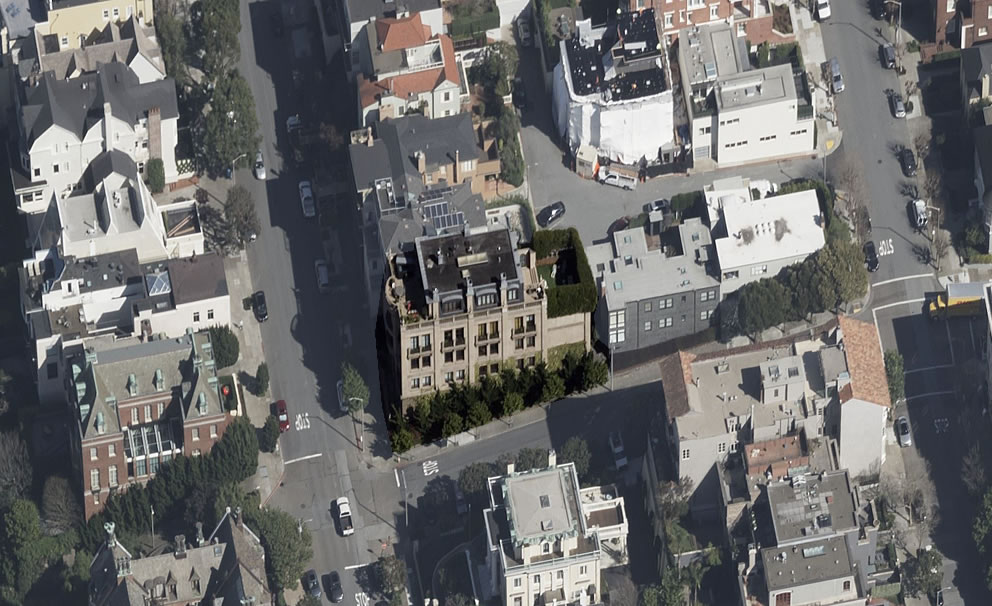Acquired by the founders of Bebo and The Battery (dibs on the band name) for $29 million in 2008, despite it not being on the market at the time, the 11,635-square-foot, 7-bedroom Billionaires Row mansion at 37 Raycliff Terrace was subsequently remodeled, re-decorated (by Ken Fulk), and rebranded 2799 Broadway.
Positioned a “one of San Francisco’s premier properties,” with panoramic views “stretching from the Golden Gate Bridge to Marin, across the bay to Alcatraz and beyond;” “stellar craftsmanship and luxe finishes” throughout; a sunny, walk-out south lawn; and a stunning view terrace with a new spa overlooking the city and bay, the 7-bedroom home returned to the market priced at $39 million four years ago.
Re-listed for $37 million in 2020 and then again for $35 million last year, the asking price for 2799 Broadway has just been dropped to $32 million, a sale which would be considered to be “at asking” according to all industry stats and aggregate reports. If you think you know the market for Billionaires Row and the like, now’s the time to tell.













It’s gorgeous, but it’s too big. These mansions are out of scale for what millennials want. I suppose if you were ultra wealthy and had four kids, it could make sense, but there’s essentially no backyard which hurts that buyer profile. Personally, speaking as a millennial, my dream house probably tops out at around 5K-6K square feet. Just like I see the 1K square foot white box unit depreciating more than average in the next 10-50 years, I see these mega mansions declining over time as well.
I’ve always thought this house looked too much like a hotel. I agree with Panhandle Pro that anything more than 5K-6K is just too much. A home should be somewhat cozy so you get to see your family once in a while.
Acquired in 2008 for $29M.
Any insight into the cost of remodel or improvements?
Wonder if the house has been occupied during all this time or if it was a spec renovation. That’s a lot of carrying costs on a property which is probably declining in value with every day that passes.
Hard for me to opine on this type of property since, like the other commenters, it’s just much larger than anything I’d ever want to live in, even if somebody handed it to me for free, I’d sell it to buy something smaller.
This seems like a home for someone wealthy who is forced to live with a family they despise and hope to only see infrequently, perhaps occasionally passing in the halls.
No Pool?
Even staged, the pictures also do not depict a true home, but instead the design statement of a hired third-party.
Houses such as this can be a statement for new San Francisco residents that “We have arrived” (so take notice of us). This results from outsiders viewing exclusive neighborhoods as a private club to which money provides membership. The issue, however, is that ostentatious wealth displays alienate old true friends, while not guaranteeing access to wealthy new ones. “New” money is then in social limbo and often moves on in search of a place where they feel they can belong.
Buyer beware: Trying to re-invent one’s self and ingratiating into a provincial social environment (that thrives on exclusion) takes a long time and is best achieved by being subtle and patient.
Actually much bigger trophy properties can be found in southern california market. It is possible to make money on these trophy properties by remodeling and holding for 10 years or so. Don’t know about this one.
Is this just a rough draft, or the actual sermon you’ll be delivering Sunday ??
I liked it. Could be a great start on a purposeful derashot, as well, you know.
The part about “New money being in social limbo and moving in search of a place where they feel they can belong” could easily describe several if not most of the newly-minted billionaires and centi-millionaires around here. Peter Thiel leaving for Los Angeles. OpenAI’s Sam Altman owns a $27 million house on Russian Hill but also bought a ranch in Napa. Travis Kalanick, the list goes on.
If I was in that socio-economic strata, though, I wouldn’t hesitate to buy this house and happily live in it with my live-in domestic staff without a single care about what old money S.F. thinks.
It was observational, not judgemental…well, no more judgemental than an RDA of snark implies.
It certainly is elegant. Needs grounds, though, extensive grounds…
The “art” throughout the house is terrible.
This discussion of old money vs new money is a bit odd on this site. There are all sorts of old money, and many degrees of social distinction. One would have to be naïve to believe that buying a house –especially perhaps this new and overdone house– would lead to prompt inclusion in any social group, much less one based on class.
There is a huge scholarly and popular literature, historical, sociological, economic, on class structure, and one commonality is recognition that money alone, no matter how much, will not gain entry. That is why rich people, little by little, support the arts and charity, send their kids to good schools, join modest and then better clubs, and bide their time.
As Herb Caen memorably said, social mountaineers in SF may find that they end up at the top of nothing whatsoever.
One would have to be naïve to believe that buying a house –especially perhaps this new and overdone house– would lead to prompt inclusion in any social group, much less one based on class.
But isn’t that the whole point: new money is naive. (whereas there may be “all sorts” of old money, there’s only one type of new money). That, at least is the stereotype. How true it is I can’t say – like any stereotype I believe it has a core of truth, but is simplistic – but I doubt many on here speak from experience: despite self-puffery from a few posters, commenting on a local real estate board seems like neither a way to get ahead…nor stay there.
If the discussion is odd, why then do you ramble on about it?